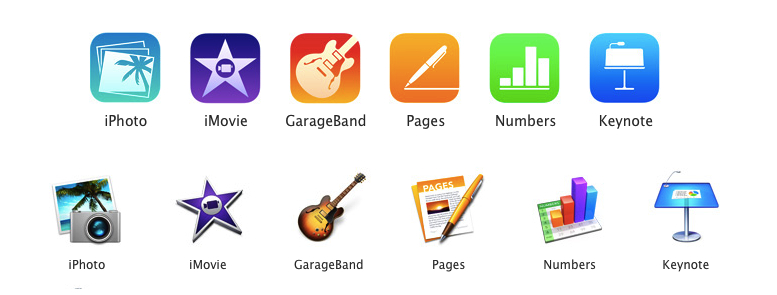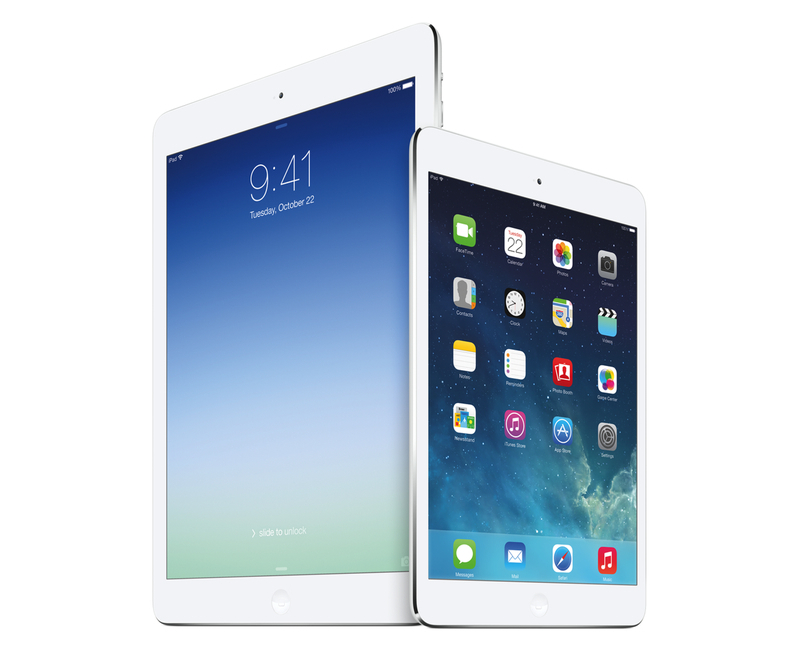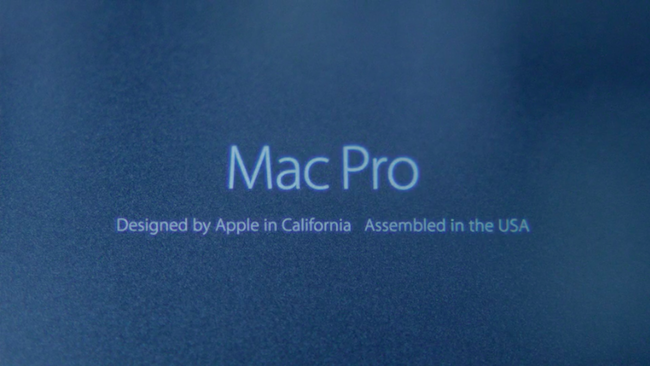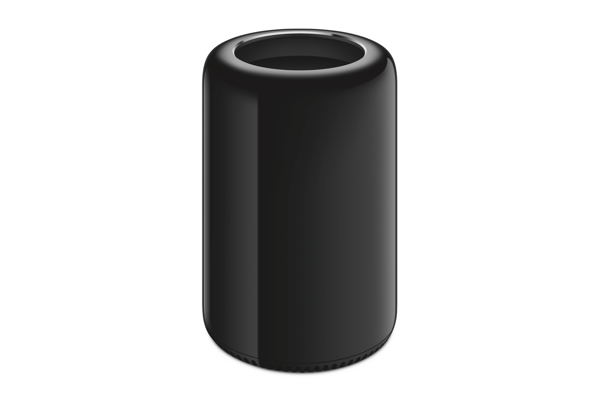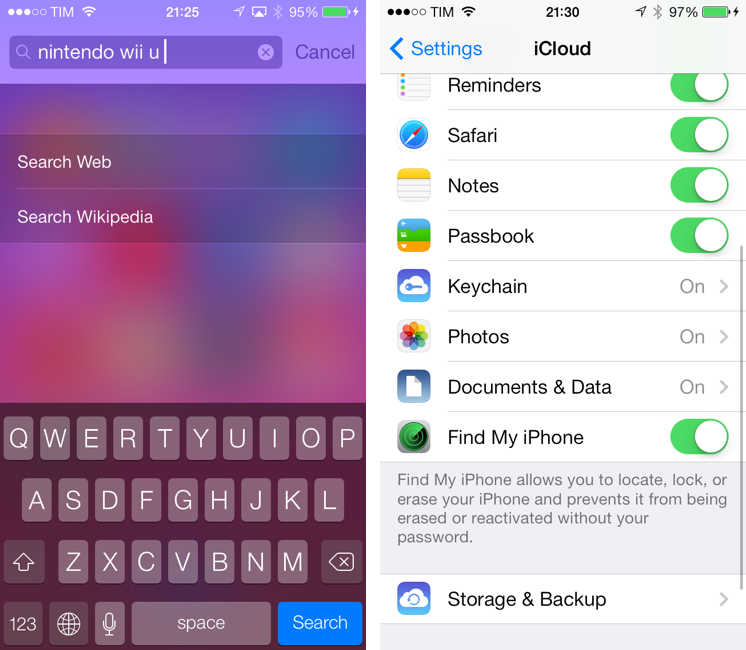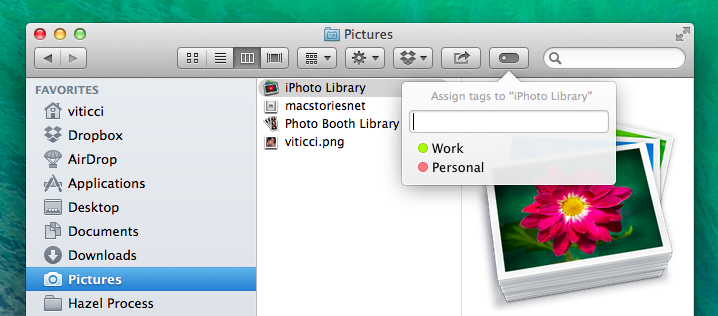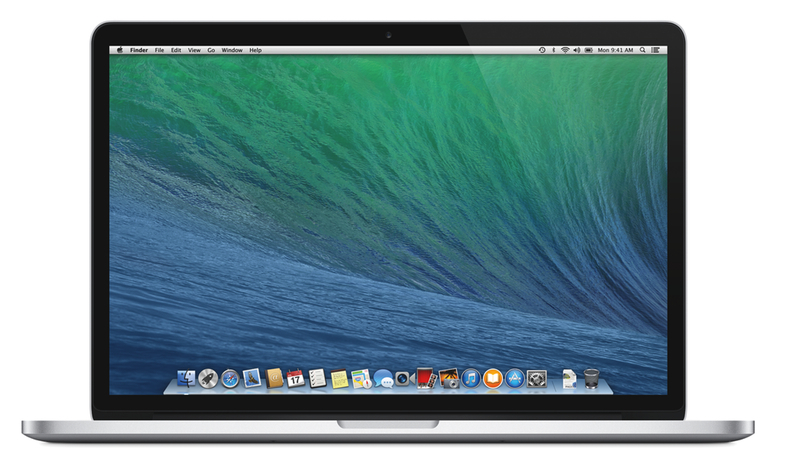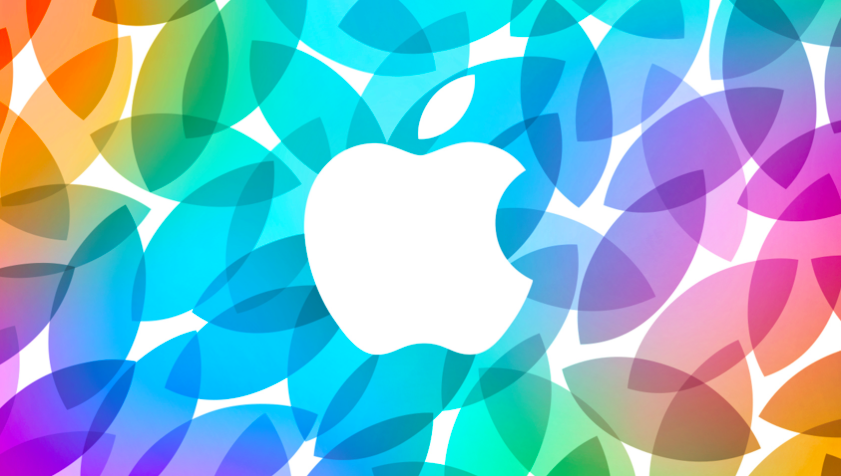Perhaps today’s most interesting announcements weren’t new iPads or Macs, but Apple’s range of software. It’s been a while since the iWork suite of apps have received updates on the desktop, and iLife apps such as iPhoto, iMovie, and GarageBand looked outdated as soon as iOS 7 arrived on iOS devices in September. You’re probably wonder what the skinny is around all the new apps and whether you qualify to get those apps for free. This won’t be an exhaustive overview, but ask and you shall receive.
Overview: Apple Updates iLife and iWork Apps, Makes Them Free for New Customers
iPad Air and Retina iPad mini: Our Complete Overview
Phil Schiller took the stage today at Apple’s media event at the Yerba Buena Center for the Arts in San Francisco to officially unveil the iPad mini with Retina Display – the long-rumored successor to last year’s iPad mini – and the iPad Air, Apple’s new full-size iPad that replaces the old 4th generation iPad. Read more
New Mac Pro Begins Shipping in December for $2999
Previewed during this year’s WWDC Keynote, Phil Schiller already gave us a run down of what to expect with the new Mac Pro. The last piece of the puzzle would be availability, and today it was revealed that the new Mac Pro’s will begin shipping in December, starting at $2999. But what does three grand get you? Here’s a refresher:
Big performance gains in a package 1/8th the size of the current Mac Pro
The new Mac Pro is all about being small, quiet, yet entirely capable of delivering performance for today’s audio and visual professionals. The Mac Pro, unlike desktop towers of old, has been designed into a compact round aluminum canister that sucks heat away from components using a single unified thermal core. While uniquely shaped, components in the new Mac Pro are user accessible, with connectivity to server racks and other peripherals being mitigated through an array of Thunderbolt 2 ports.
The heart of the new Mac Pro consists of an Intel Xeon E5 processor that comes in 4, 6, 8, or 12-core configurations. These processors will have up to 30 MB of L3 cache, and up to 40 GB/s of PCI Express gen 3 bandwidth. On the memory front, Apple’s including up to 64 GB of 1866 MHz ECC memory, all coordinated via a four channel controller which allows up to 60 GB/s of bandwidth. Then there’s those dual GPUs: two AMD FirePro graphics cards with up to 4096 stream processors and up to 12 GB of GDDR5 VRAM. The two cards can deliver a total of 528GB/s of bandwidth. Storage, like recent Mac improvements, is also being bumped into the PCIe-based flash storage realm, with capacities up to 1 TB available. Professionals can expect up to 1.2 GB/s writes and 1.0 GB/s reads.
Connecting the Mac Pro to the outside world is its I/O panel, which features six Thunderbolt 2 ports, 4 USB 3 ports, dual Gigabit ethernet, and HDMI out. Thunderbolt 2 ports support 20 GB/s of throughput, with up to six devices able to connect per port. The Mac Pro’s greatest asset is that it can power up to three 4k single and dual-input displays. Just like the MacBook lineup, 802.11ac and Bluetooth 4.0 for wireless connectivity is standard.
The base configuration Mac Pro at $2999 comes with:
- 3.7 GHz quad-core Intel Xeon E5 with 10 MB L3 cache and Turbo Boost up to 3.9 GHz
- 12 GB of 1866 MHz DDR3 ECC memory
- Dual AMD FirePro D300 graphics processors with 2 GB of GDDR5 VRAM each
- 256 GB PCIe-based flash storage
For more information on the new Mac Pro, visit Apple.com.
For more coverage, check out our October 22 news hub and follow @macstoriesnet on Twitter.
Apple Releases iOS 7.0.3 with Updated Reduce Motion Setting, Spotlight Improvements, iCloud Keychain, and More
Apple has today released iOS 7.0.3, bringing several bug fixes and enhancements as well as some new and tweaked features to the OS that was released last month.
On the feature side, iOS 7.0.3 introduces support for iCloud Keychain, which allows you to keep Safari passwords and credit card information in sync across your iPhone, iPad, and Mac running the just-released OS X Mavericks. Once enabled, iCloud Keychain will be available in Settings > iCloud, encrypting information as you use Safari.
Second, iOS 7.0.3 brings back the ability to search Google and Wikipedia from Spotlight. The feature had been removed from the first release of iOS 7, but it’s now back in the new Spotlight, which is always available in any Home screen page just by swiping down. Read more
Apple Updates 13-inch and 15-inch MacBook Pros With Retina Displays With 4th-Generation Intel Processors
Having updated their lineup of MacBook Airs earlier this year, Apple has turned their attention to the MacBook Pro lineup, updating the 13-inch and 15-inch models with more powerful hardware while cutting prices for customers. These updates were announced by Phil Schiller at the Yerba Buena Center in San Francisco, California, during today’s Keynote.
13-inch MacBook Pro with Retina display:
The biggest complaints with previous generation MacBook Pros is that their hardware couldn’t keep up with the Retina display. Many reviewers found the initial 13-inch model to be somewhat lackluster in performance, with laggy scrolling noticeable throughout the OS X interface. With today’s update, the 13-inch model is getting some notable improvements.
First up are design changes to the chassis, with the 13-inch model shedding size and weight. It’s both lighter and smaller than before, weighing only 3.46 pounds and measuring at only 0.71 inches thin.
Next are the performance improvements. New buyers can expect greatly improved performance thanks to Intel’s Haswell processor, and integrated Intel Iris graphics. As the new processor is much more power efficient than what’s found in previous models, the 13-inch model now gets up to 9 hours of battery life when web browsing or watching iTunes movies. As Phil Schiller said on stage, you could watch Christopher Nolan’s Batman trilogy and still have battery life to spare. Just like the new MacBook Airs, the 13-inch MacBook Pro has received PCIe-based Flash storage, 802.11ac for wireless, and updated Thunderbolt 2 ports.
In terms of performance gains, the new processors are 90% faster than the previous generation, wireless throughput is 3x better at similar distances when compared to 802.11n, and flash speeds are 60% faster than before.
The base model 13-inch MacBook Pro with Retina display has been reduced in price by one hundred dollars, starting at only $1299 with the following specifications:
- 2.4 Ghz dual-core Intel Core i5 processor
- 4 GB of 1600 MHz DDR3L memory
- Intel Iris graphics
- 128 GB PCIe-based flash storage
15-inch MacBook Pro with Retina display:
Unlike it’s smaller sibling, the 15-inch model hasn’t received any design changes to its chassis. All of the base improvements found on the 13-inch model are found on the 15-model. 802.11 ac wireless, PCIe-based flash storage, and Thunderbolt 2 come equipped in addition to processor and graphics improvements.
Instead of opting for a dual-core processor, however, Apple is configuring their 15-inch models with a quad-core Crystalwell processor that also comes with integrated Iris Pro graphics from Intel. Optionally, customers can choose to add a discrete graphics solution, Nvidia’s GeForce GT 750m, with 2 GB of video memory that’s great for editing video or playing games. Despite having all this newfound power, the 15-inch model will get up to 8 hours of battery life when browsing the web or watching movies from iTunes.
The base model 15-inch MacBook Pro with Retina display has been reduced in price by two hundred dollars, starting at only $1999 with the following specifications:
- 2.0 GHz quad-core Intel Core i7 processor
- 8 GB of 1600 MHz DDR3L memory
- Intel Iris Pro graphics
- 256 GB PCIe-based flash storage
Both models start shipping today, and can be configured from Apple’s Online Store. For more information, see Apple’s updated MacBook Pro pages at Apple.com.
For more coverage, check out our October 22 news hub and follow @macstoriesnet on Twitter.
Apple Posts October 22 Keynote Video→
For those who didn’t catch the live stream on Apple’s website, Apple just posted a video of this morning’s keynote in its entirety. The video can be streamed here, and a higher quality version should be made available in a few hours through iTunes. To avoid streaming errors, Safari is recommended for the best viewing experience.
We will post additional news on the site’s homepage, or tweet as @MacStoriesNet throughout the day. Check out our October 22 news hub for complete coverage of today’s announcements.
Update 8 PM EDT: The keynote is now available for download on iTunes through the Apple Keynotes podcast.
For more coverage, check out our October 22 news hub and follow @macstoriesnet on Twitter.
OS X Mavericks: Tips, Tricks, and Details
Mavericks is the latest version of OS X that builds upon the foundation of Mountain Lion to offer new apps like Maps and iBooks, redesigned system apps, and new energy-saving technologies like App Nap and Safari Power Saver. For power users, Mavericks sports additions like improved multiple displays, Finder tabs, tags, and AppleScript Libraries.
At MacStories, we enjoy finding all the little tweaks and hidden features that come with a brand new OS X version each year. In this post, you’ll find over 70 tips, tricks, and details of OS X Mavericks that we’ve collected throughout the summer since the first beta release the new operating system.
Mavericks’ release was announced today at Apple’s media event in San Francisco, and it’s available for free on the Mac App Store. We will have more articles on Mavericks throughout the week in our Mavericks hub on MacStories.
In the meantime, you can enjoy our collection of tips and tricks to get the most out of Mavericks, and read my article on working with Mavericks.
Read more
Apple Announces Mavericks Will Be Free, Available Later Today
Apple has announced that their next major OS update, OS X Mavericks, will be available today, Tuesday, October 22nd.
Mavericks brings better multitasking to the Mac with improvements to the Finder and multiple displays. Finder tags let anyone organize their documents with colorful descriptions that organize documents under a single, searchable keyword. And Finder tabs let you browse your filesystem like the web, reducing the number of open windows needed to move files between folders. Better handling for multiple displays lets Mavericks handle each connected monitor individually, so you can use fullscreen apps and desktop apps at the same time. These improvements also carry over to AirPlay and the Apple TV, which allows the TV to become a second display.
Mavericks also features two brand new desktop versions of Maps and iBooks. Maps contains all the same key features as the iOS version, including Flyover for viewing locales in 3D, local search, and Yelp reviews. With Maps on the Mac, you can even send directions to the iPhone so that they’re ready when you need them. With iBooks, you can read eBooks purchased in the iBooks Store on your desktop, make highlights, and share your notes with other devices through iCloud.
Lastly, Mavericks updates Safari with a host of new ways to find cool stuff and log into websites more readily than before. Underneath an updated design, Safari’s new sidebar introduces Shared Links, a quick way to view websites shared by friends and colleagues on Twitter and LinkedIn. And thanks to iCloud Keychain, you can log into websites with a simple click, and generate hard to guess passwords when you’re ready to register with another.
Mavericks will be available to download in the Mac App Store for free. You can upgrade from Snow Leopard, Lion, and Mountain Lion in a single-step update.
Update: OS X Mavericks is now available on the Mac App Store.
For more coverage, check out our October 22 news hub and follow @macstoriesnet on Twitter.
The Numbers From Apple’s October 22 Event
Every year, Apple kicks off their keynotes start with a “state of the business” introduction that, with various numbers and facts, reveals how the company is doing in several areas such as retail, the App Store, iOS device sales and software upgrades, and Mac sales. At today’s media event in San Francisco, Apple CEO Tim Cook shared some interesting details on a variety of subjects.
- 9 million iPhones sold in opening weekend, making it the biggest launch ever.
- Apple played a video about the iPhone 5s and 5c launch around the world with OneRepublic’s “Life In Color” playing in the background.
- Five days after the iOS 7 launch, 200 million devices were running the OS (biggest software launch ever for Apple). As of today, 2/3 of Apple’s iOS devices (64%) are running iOS 7.
- iTunes Radio has so far had over 20 million listeners that have listed to over 1 billion songs.
- The App Store now has 1 million apps and users have downloaded over 60 billion apps to date. Developers have earned over $13 billion with the App Store.
- With Mavericks, the 13-inch MacBook Air can get over an hour of extra battery for web browser.
For more coverage, check out our October 22 news hub and follow @macstoriesnet on Twitter.


